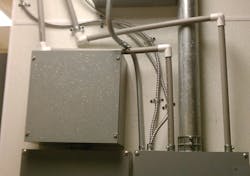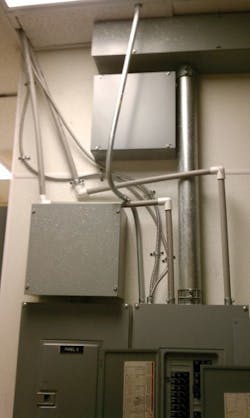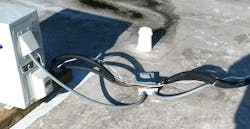Illustrated Catastrophes: 110.8, 300.15, 358.30, 352.30, 312.2, and 352.30
All references are based on the 2011 edition of the NEC.
A Feast of Plenty
Heath Ward, a journeyman electrician/foreman, discovered this cornucopia of connectors, smorgasbord of support problems, and mix of violations in a convenience store in Dallas while disconnecting power to one area of the store for a remodel project. I’ll begin by pointing out the use of plumbing elbows incorrectly used with this PVC. Those short white elbows may be good for flowing water but are really bad for pulling wires. Section 110.8 informs us that only recognized wiring methods are included in the Code. This does not include plumbing fittings. The next violation is the use of EMT connectors on the PVC pipe and the MC cables connected to the top of the panel. This violates Sec. 300.15, which requires wiring methods to be used with fittings designed and listed for the specific wiring method installed. This could also create bonding and grounding problems for those metal cable jackets. The next violation is the lack of supports on the EMT and some of the PVC pipes. These pipes should be supported in accordance with 358.30 and 352.30, respectively, both of which require the pipe to be supported within 3 ft of the enclosure to which it is connected.
A Floppy "Disc-Connect"
This photo was sent in by Larry Ward, a senior electrical engineer with Hooker/DeJong, Inc. in Muskegon, Mich. He found the disconnect for this rooftop air-conditioning unit just flopping around like a newly caught fish. Apparently, using proper supporting techniques were optional for this installer. This disconnect is meant to be weatherproof; however, the way in which it is positioned on the roof leaves it to possibly fill with rainwater. Section 312.2 requires surface-type enclosures to be mounted and secured in a manner that will prevent water or moisture from entering the enclosure. The position and lack of support could also make it difficult for service personnel to turn it off. This could increase the shock and arc flash hazard for that person if he has difficulty disconnecting the power. Section 352.30 requires liquidtight flexible metal conduit (LFMC) to be securely fastened within 12 in. of each enclosure and supported at intervals of no greater than 4½ ft. Exception No. 2 does allow LFMC of sizes ½ in. through 1¼ in. to be unsupported for up to 3 ft from the enclosure; however, the lengths in the photo appear to be longer than these distances.
About the Author

Russ LeBlanc
Owner
Russ started in the electrical trade as an apprentice in 1985. He worked his way up to become a Journeyman Electrician and then eventually became a Master Electrician and Licensed Construction Supervisor. In 1999 Russ become an Electrical Instructor for The Peterson School of Engineering in Massachusetts where he developed his passion for teaching, and quickly became Department Head of Electrical Instruction. Russ has taught thousands of apprentices, electricians, engineers, inspectors, and other electrical professionals during his career as an instructor. He continues to provide electrical professionals with Electrical Code seminars, Arc-Flash Awareness training seminars and educational material through his LeBlanc Consulting Services in North Reading, MA whose specialty is educating electricians. He has been an active member of the NFPA Electrical Section and has authored hundreds of National Electrical Code proposals and comments which have become Code rules to improve the safety for the electrical industry. Russ is also an IAEI certified Electrical Inspector.
Please visit www.russleblanc.net for more information.


